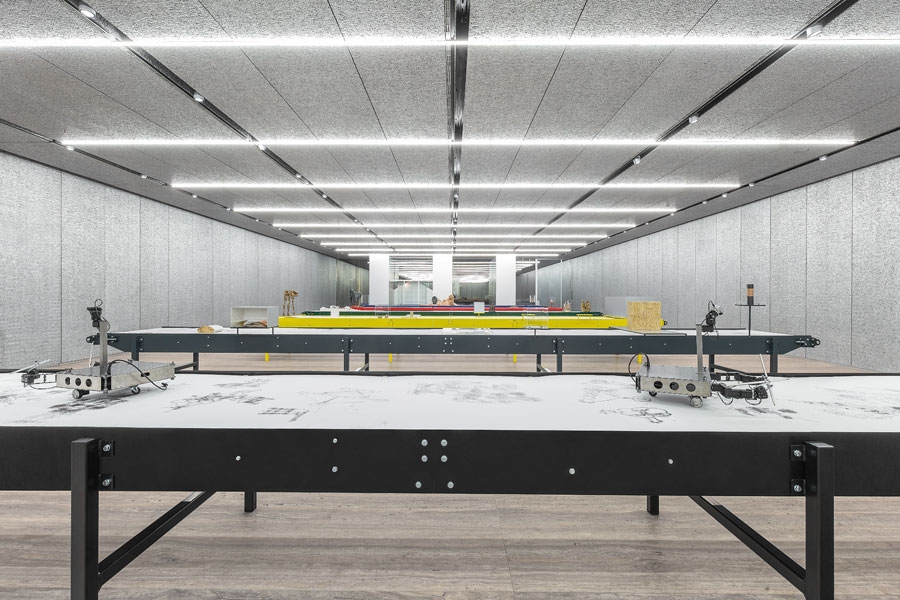4 February – 19 June 2016, Fondazione Prada, Milan
“Hello, Doctor. I’m ready for my lesson”: an animatronic man is talking. We are in the cavernous ground-floor space of the Podium, one of three locations in the Fondazione Prada occupied by Goshka Macuga’s exhibition, and we are viewing To the Son of Man Who Ate the Scroll (2016). Macuga has created this benign creature with the help of some boffins at Japanese robotics company A-Lab. The black-bearded figure looks not unlike the British comedian Sacha Baron Cohen; it would be wrong, though, to expect jokes. He is seated comfortably and his accent and pedagogical demeanour are more reminiscent of Antony Sher in the actor’s younger years. Macuga has collated a selection of mankind’s greatest speeches for the robot to utter, a history lesson from a fake history man. Both his feet are encased; the left in a cardboard block, the right in some gloopy gunk done in a lurid pink. Feet of clay, then: over-obvious symbolism about humanity and its pretensions (but perhaps also a neat jibe at Prada and its footwear).
This replicant rhetorician majors in endings. In his calm, unhurried tone, he tells us that “what we have now… is going to be finished”. One suspects he, and perhaps Macuga too, cannot wait to bring it on. Indeed, if the ministrations of the Prada staff are anything to go by, there are worrying signs that he himself is not immortal. The poor fella blinks disconcertingly as his carers adjust some transparent plastic wrappings on his ever-gesticulating arms. Macuga’s robot-teacher has none of the menace of Jordan Wolfson’s scary (Female Figure) (2014). He is more like a giant Action Man doll, the type that speaks when someone pulls its cord. We might imagine him shouting martially at the various sculptural works by other artists that Macuga, in her established manner, has curated, filling the room where he sits: “Stand in line, Lee Byars!” maybe, or “Attention, Fontana!” Elsewhere, the parade includes works ranging in time of construction from Giacometti’s Cubo (1934) to Phyllida Barlow’s Untitled: hanginglumpcoalblack (2012).
Upstairs, in the first floor of the Podium, meanwhile, is another collaboration using new technology to illustrate what we as a species may leave behind. Macuga gives us five tables constructed in collaboration with robotics artist Patrick Tresset, collectively titled Before the Beginning and After the End (2016). Each holds various artworks such as (controversially here in Milan) Renato Bertelli’s Profilo continuo (Testa di Mussolini) (1933) and – more clay – Fischli and Weiss’s Brick (2005). The works in turn sit on 9.5m paper scrolls covered in biro sketches and texts drawn by Tresset’s robot drawing machines. We see scribbled versions of works by a disparate range of artists, from Goya to Raymond Pettibon. What’s going on here? One might see the tables as a Brobdingnagian version of that Golden Record aboard the unmanned spacecraft Voyager on its journey to the outer limits: a huge trove of art sent to enlighten other lifeforms. This is what we are, then; the best of us, perhaps. Or, in Macuga’s own sceptical words in a neon text piece here, What Was I? (2016).
The huge show continues with what Macuga calls an International Institute of Intellectual Co-operation (2015), 11 groupings of famous heads in bronze, linked by long poles. One, with scattergun intemperance, connects Edward Snowden and Jim Jones under the subtitle ‘End of History’. There’s a grandiloquence here that makes one yearn for a more contemplative approach to what we might leave behind, as with Italian writer Giorgio Bassani’s modest take on that ‘which we’ll not live to see and which will not remember us’. Macuga’s pessimism and hopelessness, by contrast, are tinged with adolescent whining that ‘everything’s shit’. The message is as deliberately heartless as that malfunctioning mannequin.
This article was first published in the May 2016 issue of ArtReview.
